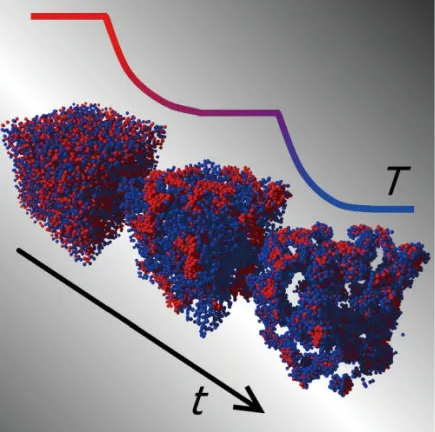DNA—纳米粒子自组装胶体可带来智能材料
瑞士联邦理工学院(EPFL)和英国剑桥大学科学家最近合作开发出一种技术,用DNA链给纳米粒子涂上一层涂层,能控制并引导两种不同胶体的自动组装。这种胶体粒子可用于制造新奇的自组装材料,如智能递药补丁、随光变色的新奇涂料等。相关论文发表在《自然·通讯》杂志上。
胶体是一种物质在另一种物质中均匀分布而形成的。日常生活中人们能看到许多胶体,如牛奶、泡沫塑料、发胶、涂料、泡沫刮胡膏、胶水甚至灰尘、泥浆、烟雾等。胶体有很多独特的性质,如布朗运动、电泳、丁达尔效应(光进入胶体发生散射并呈现出不同色彩)等,但更特殊的性质在于它们的自组装能力:只在本身粒子的相互作用下,就能自然地聚集在一起,形成一种稳定的结构性排列,而无需外力干预。通常只要温度、光照等外部环境因素发生变化,胶体就会作出反应而发生这种自组装。在生物性胶体中,如DNA、蛋白质及其他大分子,自组装通常是自组织的第一步,支撑着许多分子结构。但就技术方面来说,自组装胶体用途更广泛,人们对其研究得也更多。
如果两种或更多种不同的胶体在一起,它们的自组装会怎样?瑞士联邦理工学院约瑟佩!弗菲的小组与剑桥大学埃利卡·艾瑟的小组合作,共同解决了这一问题。艾瑟小组用不同的DNA链给荧光聚苯乙烯小球涂上一层涂层,让小球外表变得毛毛的,作为粒子相互作用的手段,也可以用于标记不同的粒子,还能利用DNA序列的适配性给粒子间的相互作用编程。
利用DNA—涂层胶体,研究人员能控制两种不同胶体微粒的自组装进程。两种胶体以一种“双混”的形式混合在一起,最终形成了新的结构,并且它们聚集得更快,由此生成一种结构性“基架”,可以在上面装配其他东西。利用DNA碱基对的选择性,研究人员对胶体外形的控制达到了前所未有的程度。
此外他们还发现了一种获得自组装结构的方法。由于胶体微粒对温度变化的反应提供了高度特异性和可编程性,自组装结构在很大程度上取决于温度变化。弗菲说:“从某种意义上说,新结构保留着它们制备历史的‘记忆’。”
根据胶体外形数据和粒子相互作用的动态数据,研究人员推断,这种方法并不局限于纳米级物体,还可用于整个胶体范围。此外他们预测,这种方法还有许多应用,如光反应涂料或智能补丁,智能补丁里填充着装有抗体或退烧药的粒子,并能随体温或pH值变化起反应,释放出这些粒子。
DNA brings materials to life
DNA-coated colloids have been used to create novel self-assembling materials in a breakthrough experiment by EPFL and University of Cambridge scientists.
A colloid is a substance spread out evenly inside another substance.Everyday examples include milk,styrofoam,hair sprays,paints,shaving foam,gels and even dust,mud and fog.One of the most interesting properties of colloids is their ability to self-assemble–to aggregate spontaneously into well-defined structures,driven by nothing but local interactions between the colloid's particles.Self-assembly has been of major interest in industry,since controlling it would open up a whole host of new technologies,such as smart drug-delivery patches or novel paints that change with light.In a recent Nature Communications publication,scientists from EPFL and the University of Cambridge have discovered a technique to control and direct the self-assembly of two different colloids.

Contrary to solutions that are made up of discrete molecules,colloidal solutions are made up of large particles,dispersed in a liquid solvent.This unusual structure gives colloids unique properties such as Brownian motion (the random zig-zag movement of particles as they collide with the molecules of the dispersion medium),electrophoresis (the unidirectional movement of particles under and electric current)and optical properties such as the Tyndall effect(light entering a colloid scatters and exits as a different color).It is because of such properties that colloids are so commonplace in everyday life;but one particular property holds special interest:selfassembly.
Self-assembly refers to the ability of a colloid's particles to spontaneously form a kind of stable structural arrangement as a result of the shape and direction of the colloid's particles as theyinteract with the dispersal medium.Although no external force is required,self-assembly generally takes place as a response to a change in an environmental factor such as temperature,light,etc.In biological colloids like DNA,proteins and other macromolecules,self-assembly is usually the first step to self-organization,which underlies many cellular structures.But in terms of technology,selfassembling colloids could have a wide range of applications,fuelling much research in the field.
But what about selfassembly of two– or more–species of different colloids? This is the question addressed by Giuseppe Foffi's group at EPFL,working in collaboration with Erika Eiser's group at the University of Cambridge.
The scientists showed that when the interactions between the particles of two different colloids are carefully designed,they result in the formation of new structures.Specifically,they have discovered a ways to obtain self-assembled structures that depend strongly on temperature changes.Giuseppe Foffi says:"In a sense,the new structures have a 'memory' of their preparation history."

